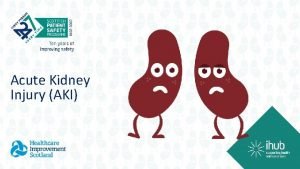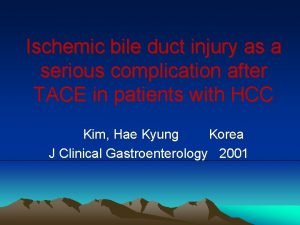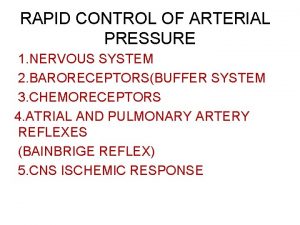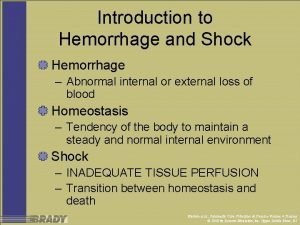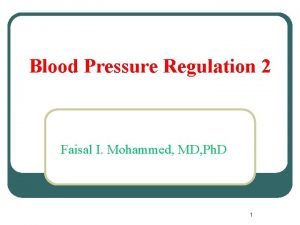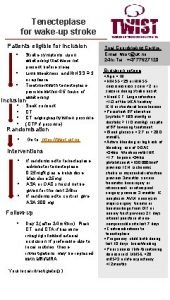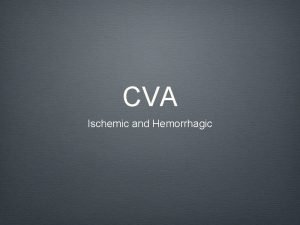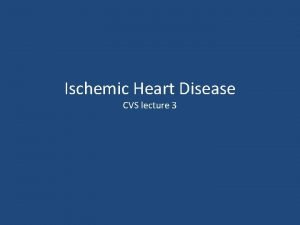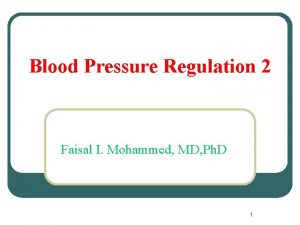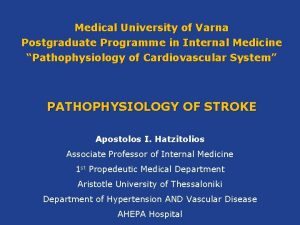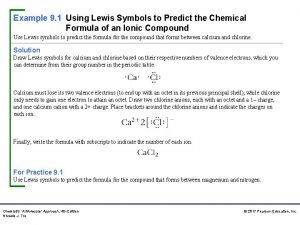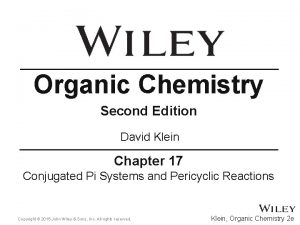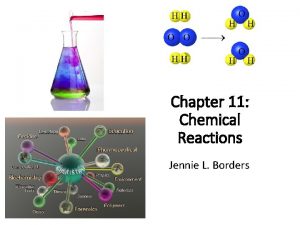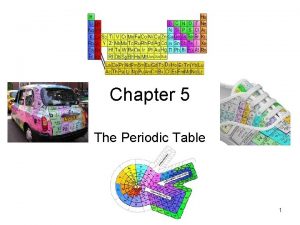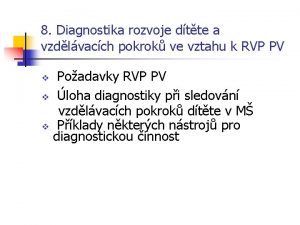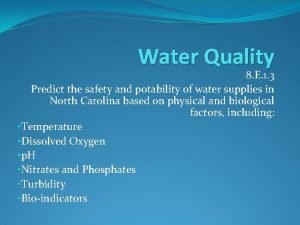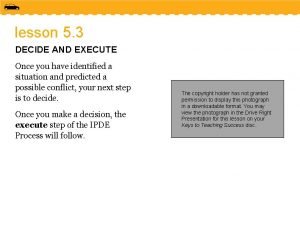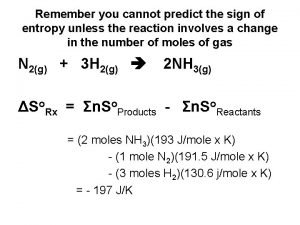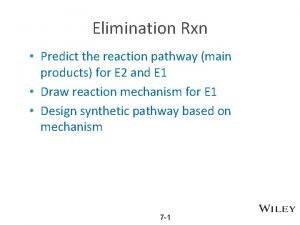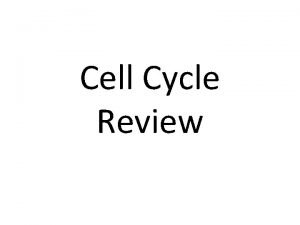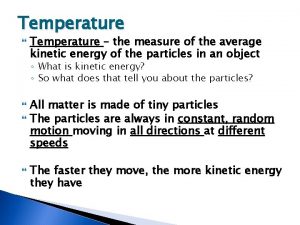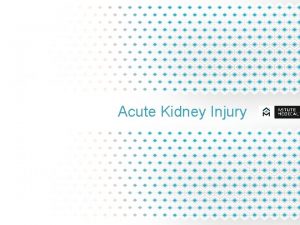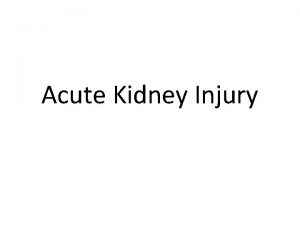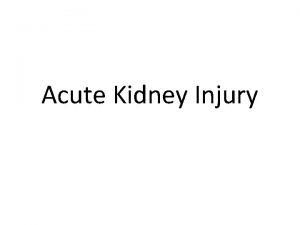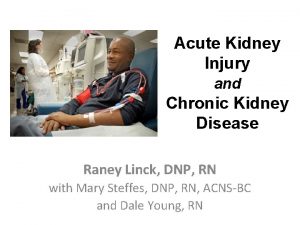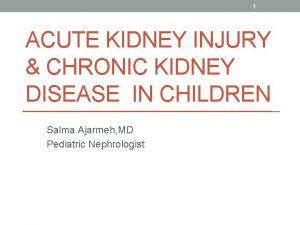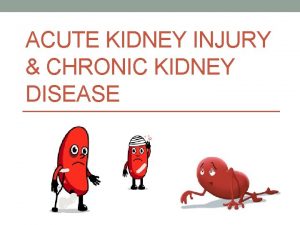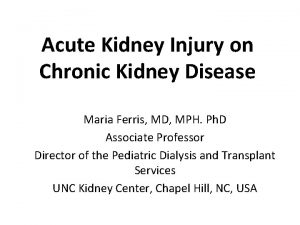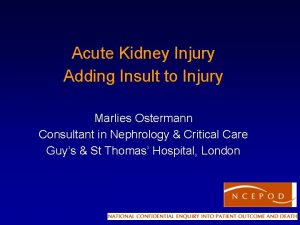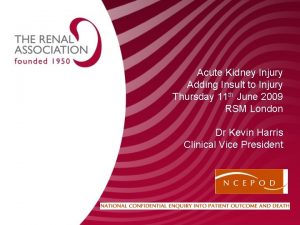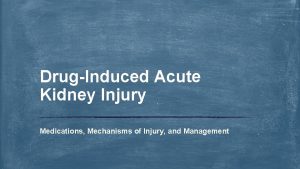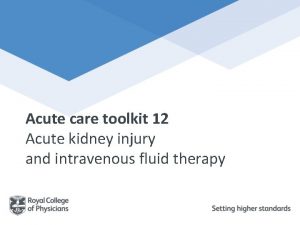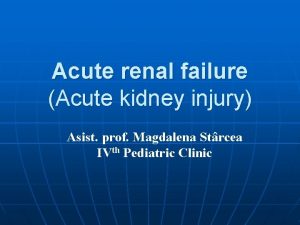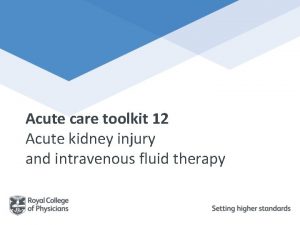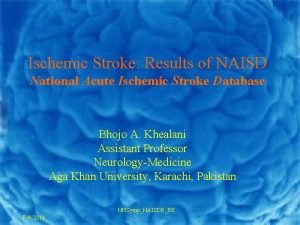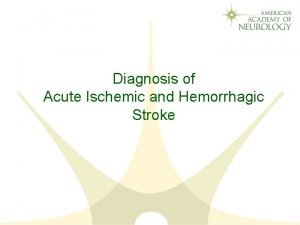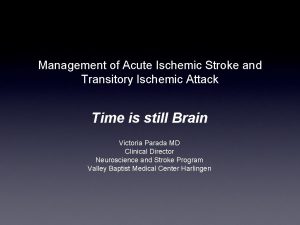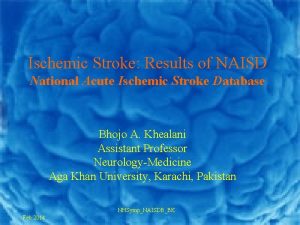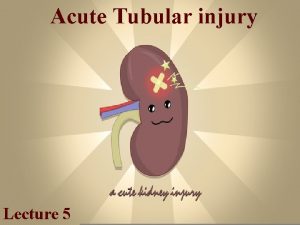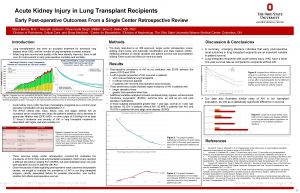URINARY NETRIN1 PREDICT EARLY ISCHEMIC ACUTE KIDNEY INJURY































- Slides: 31

URINARY NETRIN-1 PREDICT EARLY ISCHEMIC ACUTE KIDNEY INJURY AFTER CARDIOPULMONARY BYPASS Mohammad Hasan Aly¹, Alsayed Alnahal¹, Goerge Emad¹, Abdel Azim M. Jumaa², Mohammad Mamdouh El Shaarawy³. Internal medicine deparment ¹, Medical Biochemistrydeparment², Cardiothoracic surgerydeparment³, Faculty of medicine, Zagazig Universityq 1

Introduction

l Acute kidney injury is a common and serious postoperative complication of cardiac surgery requiring cardiopulmonary bypass (CPB), and it is the second most common cause of AKI in the intensive care unit (1). l. Mao H, Katz N, Ariyanon W, Blanca-Martos L, Adýbelli Z, , et al (2013): Cardiac Surgery-Associated Acute Kidney Injury. Cardiorenal Med J. (3): 178 -99.

l Several studies reported that even mild increases in serum creatinine levels following cardiac surgery were associated with significant effects on mortality (2) , long-term survival was depending AKI duration (3) , and early recovery of renal function was associated with improved long-term survival after CSA-AKI (3). l Ramesh G, Krawczeski C, Woo J, Wang Y, Devarajan P(2010): Urinary netrin-1 is an early predictive biomarker of . acute kidney injury after cardiac surgery. Clin JAm Soc Nephrol. ; 5: 395 -401 l. Brown JR, Kramer RS, Coca SG, Parikh CR (2010): Duration ofacute kidney injury impacts long-term survival after cardiac surgery. Ann Thorac Surg 43: 993– 9

Experimental studies have identified interventions that may prevent or treat AKI if instituted early in the disease process, well before the serum creatinine rises. The lack of early predictive biomarkers has impaired our ability to translate these promising findings to human AKI. Devarajan P (2006): Update on mechanisms of ischemic acute kidneyinjury. J Am Soc Nephrol; 17(6): 1503 -20.

l Detection of AKI may delayed in the first 24– 48 h depending on serum creatinine levels. Therefore, the need for more reliable, earlier indicators and predictors of AKI has emerged.

l The netrins are laminin-related proteins, which was discovered as a kidney injury marker during spatial and temporal expression studies in the kidney after ischemia followed by reperfusion (9). l Within hours after reperfusion, netrin-1 protein expression appears in proximal tubular epithelial cells; it also appears in urine and can be quantified immediately after reperfusion, so netrin-1 was suggested as an early diagnostic biomarker of kidney injury (10) l Wang W, Brian RW, Ramesh G (2008): Netrin-1 and kidney injury. I. Netrin-1 protects against ischemia reperfusion injury of the kidney. Am JPhysiol Renal Physiol; 294(4): F 739 -47. l.

l Netrin-1 was shown to play a role during angiogenesis, cell, tumor growth , and regulation of migration inflammation. l Netrin-1 regulates the inflammatory response of neutrophils and macrophages, and suppresses ischemic acute kidney injury by inhibiting Cyclo-oxygenase-2 (COX-2)mediated Prostaglandin E- 2 (PGE 2) production. l Ramesh G (2012): Role of Netrin-1 Beyond the Brain: From Biomarker of Tissue Injury to Therapy for Inflammatory Diseases. Recent Pat Biomark. ; 2(3): 202 -208.

Aim of the work

study the value of urinary netrin 1 as an early biomarker of ischemic acute kidney injury in cardiac surgery requiring cardio-pulmonary bypass.

Subjects and methods

l This work has been carried out in collaboration between the Internal Medicine, Biochemistry and Cardiothoracic surgery departments, Faculty of medicine, Zagazig University, during the period from December 2013 to November 2014. Subjects: l All patients who underwent to cardiac surgery using Cardio. Pulmoary Bypass (CPB) at cardiothoracic surgery department of Zagazig University hospitals, during the period mentioned above were included in the study except those who were excluded by exclusion criteria then division of total subjects into two main groups (AKI and NON-AKI groups) according to their postoperative rise of serum creatinine depending on KDIGO definition of AKI as increase in serum creatinine by > 0. 3 mg/dl within 48 hours (KDIGO Acute Kidney Injury Work Group. , 2012). Exclusion criteria: All subjects were selected to be free from: l Chronic kidney disease, hypertension (BP>140/90), diabetes mellitus, liver diseases, collagen diseases, sepsis and malignancy.

All subjects were subjected to the following: A) Full medical history and complete clinical examination. B) Routine investigations: l Complete blood picture. l Fasting plasma glucose level. l Liver function tests. l Renal function tests. C) Specific investigation: 1 - Measurement of basal serum creatinine and urinary netrin-1 by ELISA then 6 hours and 24 hours after Cardiac surgery. 2 - Calculation of glomerular filtration rate using MDRD equation basal, 6 hours and 24 hours after Cardiac surgery.

Results

l During the period of enrollment, 39 subjects who underwent to cardiac surgery using cardio-pulmonary bypass met the inclusion criteria of this study, then they were classified into two main groups: 1 -Group. A : ( AKI group): In this group of patient the serum creatinine was elevated either by 50 % of the basal level or by absolute rise 0. 3 mg/dl above the basal level 24 hrs after cardiac surgery. It included 15 patients (10 males and 5 females) with mean value +- SD of 36. 8± 8. 6 years old. There BMI with mean value +- SD of 26. 3± 3. 2 kg/m 2. 2 - Group B: (Non AKI group): No rise of the serum creatinine level more than 50% of the basal level or more than 0. 3 mg/dl above the basal level 24 hrs after cardiac surgery. It included 24 patients (13 female, 11 male) with mean age value of 37. 91± 12 years old.

Table 1: comparision of some clinical and laboratory data between AKI and non AKI groups. Age (years) BMI (kg/m 2) AKI NON AKI 36. 8± 8. 6 37. 91± 12 26. 3± 3. 2 25. 5± 2. 9 t-test 0. 472 1. 258 P Systolic BP 116. 0± 11. 2 117. 5± 12. 5 -0. 377 0. 708 73. 3± 7. 01 0. 299 0. 766 CPB time (min) 60. 6± 10. 9 44. 3± 11. 7 ICU stay (days) 4. 6± 1. 3 2. 1± 0. 3 Hb (gm/dl) 12. 9± 1. 3 13. 2± 1. 3 WBCs ( 6. 06± 1. 5 6. 68± 1. 3 Plt(x 109/L ) 193. 9± 51. 6 192. 8± 44. 8 PT(seconds) 13. 14± 1. 98 13. 2± 1. 5 2. 229 8. 360 -0. 776 -1. 343 0. 070 -0. 228 0. 041* < 0. 001** 0. 443 0. 187 0. 944 0. 821 Fasting Blood Glucose -1. 356 0. 183 0. 618 0. 457 (mm. Hg) Diastolic BP 74. 0± 6. 32 (mm. Hg) 94. 46± 9. 5 99. 1± 10. 9

Table 2: comparision of some laboratory data between AKI and non AKI groups. AKI AST IU/L ALT IU/L) Total bilirubin mg/dl Direct bilirubin mg/dl Seum albumin (gm/dl) Serum Na serum. K m. Eq/l Serum Bicarb m. Eq/l NON AKI t-test P 21. 9± 10. 1 20. 2± 8. 8 0. 550 0. 586 25. 8± 13. 3 24. 8± 13. 9 0. 214 0. 832 0. 72± 0. 3 0. 75± 0. 32 -0. 189 0. 851 0. 20± 0. 1 0. 25± 0. 14 -0. 940 0. 354 4. 06± 0. 39 4. 09± 0. 32 -0. 301 0. 765 138. 7± 3. 2 139. 3± 4. 04 -0. 519 0. 607 4. 21± 0. 6 3. 96± 0. 34 1. 626 0. 112 24. 2± 2. 5 25± 4. 6 -0. 607 0. 547

AKI NON AKI t-test P S. creatinine mg/dl Basal) 0. 86± 0. 15 0. 78± 0. 16 1. 628 Urinary netrin-1 Basal 21. 19± 46. 7 18. 9± 9. 3 1. 513 S. Creatinine after 6 hours 0. 88± 0. 41 0. 78± 0. 16 1. 628 0. 112 Creatinine after 24 hrs 1. 32± 0. 16 0. 85± 0. 18 8. 218 < 0. 001** Urinary netrin-1 after 6 h rs (pg/ml) 255. 17± 82. 3 54. 8± 45. 6 8. 560 < 0. 001** Urinary netrin-1 after 24 hrs 151. 97± 75. 2 34. 8± 24. 3 6. 755 < 0. 001** Basal e. GFR ml/min/1. 73 m 2 104. 53± 16. 8 108. 58. 4± 25. 54 -1. 559 0. 128 e. GFR after 6 hours (ml/min/1. 73 m 2) 95. 88± 13. 66 107. 22± 27. 97 -1. 724 0. 096 e. GFR after 24 hours (ml/min/1. 73 m 2) 59. 75± 11. 9 98. 84± 28. 1 -7. 50 < 0. 001** 0. 112 0. 431

Table (3): Time – course of the studied biomarker in patients with AKI versus those without AKI using repeated measures ANOVA test (General linear model): Patient category Patient with AKI Patient without AKI Biomarker Basal 6 hrs 24 hrs F P Urinary netrin -1 Pg/ml)( 21. 19± 46. 7 255. 17± 82. 3 a 151. 97± 75. 2 ab 27. 6 <0. 001** Serum creatinin (mg/dl) 0. 86± 0. 15 0. 88± 0. 41 1. 32± 0. 16 ab 14. 07 <0. 001** Urinary netrin -1 (Pg/ml) 18. 9± 9. 3 24. 8± 15. 6 21. 8± 24. 3 0. 68 Serum creatinine (mg/dl) 0. 78± 0. 16 0. 82± 0. 18 0. 85± 0. 18 a= significant as regards basal 0. 98 a= significant as regards after 6 hrs 0. 50 0. 37

Table (4): Correlation Coefficient (r) value of Urinary netrin-1 (Pg/ml) after 6 hours versus some studied parameters in AKI and Non-AKI groups: (Urinary Netrin-1) 6 r hours AKI Non- AKI P r P 0. 11 0. 47 0. 12 0. 66 0. 08 0. 63 0. 01 0. 91 -0. 31 0. 13 0. 53 0. 223 after CPB (Pg/ml) versus Age (years) -0. 43 Serum creatinine 6 hours 0. 12 after CPB (mg/dl) e. GFR 6 hours after CPB 0. 13 (ml/min/1. 73 m 2) CPB time (min) 0. 65 Hb (g/dl) 0. 34 0. 04 0. 2

Table (5): Correlation Coefficient (r) value of Urinary netrin 1 (Pg/ml) after 24 hours versus some studied parameters in AKI and Non-AKI groups: 24 h Urinary netrin-1 (Pg/ml) versus AKI r Non- AKI P r P Age (yrs) -0. 16 S. creatinine 24 0. 62 after CPB hrs 0. 55 0. 044 0. 35 0. 16 0. 08 0. 44 Hb (g/dl) -0. 3 0. 27 0. 303 0. 241 e. GFR 24 hrs after CPB 0. 71 0. 041 0. 008 0. 95 0. 05 -0. 36 0. 18 (ml/min/1. 73 m 2) CPB time (min) 0. 33

Table (6): Validity of the studied biomarker as predictor for AKI 6 hours after CPB: Biomarker Urinary netrin-1 Sensitivity specificity PPV NPV P 86. 7% 91. 7% 86. 6% 91. 6% < 0. 001** 53. 3% 66. 7% 50% 69. 5% 0. 21 86. 7% 91. 7% 86. 6% 91. 6% < 0. 001** 6 hours after CPB (pg/ml) Serum creatinine (mg/dl) Combined Urinary netrin and Serum creatinine Urinary netrin-1 (pg/ml) 6 hours after CPB Cutoff= 107. 3(pg/ml)

ROC curve of both serum creatinine and urinary netrin 1 at 6 hours after CPB surgery Serum creatinine Urinary netrin-1

Change of serum creatinine post CPB in AKI and NON- AKI groups

Change of urinary netrin-1 post CPB in AKI and NON-AKI groups

Summary and Conclusion

l Our study showed statistically highly significant elevation urinary netrin-1 at 6 and 24 hours after Cardiac surgery in the AKI group while serum creatinine failed to show any statistically significant elevation at 6 hours after cardiac surgery in the same group. l The sensitivity and specificity of urinary netrin -1 to detect AKI at 6 h after cardiac surgery was 86. 7% and 91. 7% respectively at a cutoff value of 107. 3 pg/ml. l Combined urinary netrin-1 and serum creatinine had the same sensitivity and specificity.

l In conclusion, urinary netrin-1 may be considered as early sensitive and specific biomarker of acute kidney injury at 6 hours after cadiac surgery requiring cadiopulmonary bypass instead of rise in serum creatinine that delayed 24 -48 hours after surgery in cardiac surgery associatedacute kidney injury patients.

Recommendations

1. Using basal urinary netrin-1 and 6 hours after cardiac surgery that requires CPB as an early biomarker of cardiac surgery associated-acute kidney injury. 2. Performance of more studies on large number of patients who are susceptible to acute kidney injury for detection of role of urinary netrin-1 in prediction of AKI in various groups of patients. (e. g diabetes mellites, preexisting renal disease, volume depleted …. etc)

Thank you
 Skt aki
Skt aki Ischemic bile duct injury
Ischemic bile duct injury Stroke algorithm
Stroke algorithm Intentional injury and unintentional injury
Intentional injury and unintentional injury Cns ischemic response flow chart
Cns ischemic response flow chart Superadded changes in coronary atherosclerosis
Superadded changes in coronary atherosclerosis Cns ischemic response
Cns ischemic response Bainbridge reflex
Bainbridge reflex Wake up stroke definition
Wake up stroke definition Hemorrhagic vs ischemic stroke symptoms
Hemorrhagic vs ischemic stroke symptoms Pathophysiology of ischemic heart disease
Pathophysiology of ischemic heart disease Giant cell arteritis
Giant cell arteritis Cns ischemic response
Cns ischemic response Antianginal drugs classification
Antianginal drugs classification Pathogenesis of stroke ppt
Pathogenesis of stroke ppt Early cpr and early defibrillation can: *
Early cpr and early defibrillation can: * Use the lewis model to predict the formula for
Use the lewis model to predict the formula for Predict the product for the following cope rearrangement.
Predict the product for the following cope rearrangement. Predict the products of the following reactions.
Predict the products of the following reactions. Gratifying in a sentence
Gratifying in a sentence Noble gas period 6
Noble gas period 6 Co znamená zkratka nnn
Co znamená zkratka nnn 25112005 color
25112005 color Predict the sources of water
Predict the sources of water Lane positions
Lane positions Predict cyber crime
Predict cyber crime Predict the sign of the entropy change
Predict the sign of the entropy change Predict the products of the elimination reaction.
Predict the products of the elimination reaction. Predict what would happen if cytokinesis was skipped
Predict what would happen if cytokinesis was skipped Heat is a measure of the average kinetic
Heat is a measure of the average kinetic Visualize predict connect clarify
Visualize predict connect clarify You light up my life answer key
You light up my life answer key
